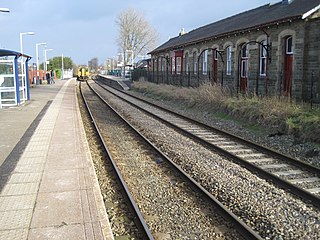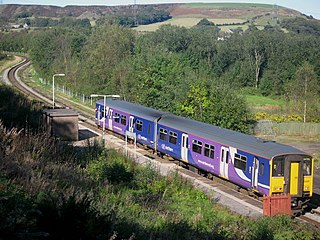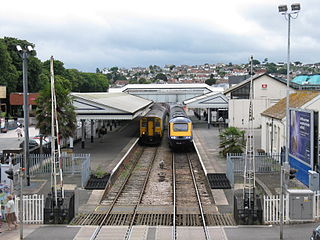
The Lancashire and Yorkshire Railway (L&YR) was a major British railway company before the 1923 Grouping. It was incorporated in 1847 from an amalgamation of several existing railways. It was the third-largest railway system based in northern England.

Blackburn railway station serves the town of Blackburn in Lancashire, England. It is 12 miles (19 km) east of Preston and is managed and served by Northern Trains.

The Ribble Valley line is a railway line that runs from Manchester Victoria through Blackburn to Hellifield in Lancashire. Regular passenger services normally run as far as Clitheroe, but occasional passenger services run the whole line through north Lancashire towards the Yorkshire village of Hellifield, where it joins the Settle–Carlisle line. The line passes over the distinctive 48-span Whalley Viaduct.
The East Lancashire Railway operated from 1844 to 1859 in the historic county of Lancashire, England. It began as a railway from Clifton via Bury to Rawtenstall, and during its short life grew into a complex network of lines connecting towns and cities including Liverpool, Manchester, Salford, Preston, Burnley and Blackburn.

Salisbury railway station serves the cathedral city of Salisbury in Wiltshire, England. It is 83 miles 43 chains (134.4 km) from London Waterloo on the West of England line to Exeter St Davids. This is crossed by the Wessex Main Line from Bristol Temple Meads to Southampton Central. The station is operated and served by South Western Railway (SWR), and is also served by Great Western Railway (GWR).

Darwen railway station serves Darwen, a town in Lancashire, England. It was opened in 1847 by the Bolton, Blackburn, Clitheroe & West Yorkshire Railway, which was subsequently taken over by the Lancashire and Yorkshire Railway twelve years later. It is now served by Northern Trains services on the Ribble Valley Line from Rochdale/Manchester Victoria to Blackburn and into Clitheroe.

Entwistle railway station is 5+3⁄4 miles (9.3 km) north of Bolton and serves the village of Entwistle. It is also the closest station to Edgworth. Unlike nearby Bromley Cross the station lies outside the Transport for Greater Manchester boundary, meaning that passengers cannot take advantage of their special offers and ticketing. Owing to the remote location and low passenger numbers, Entwistle has been a request stop for several years, however since 21st May 2023, it is no longer a request stop, and all trains stop here. It is served by Northern services on the Ribble Valley line towards Blackburn and Clitheroe in England.

Bolton Interchange is a transport interchange combining Bolton railway station and Bolton Bus Station in the town of Bolton in Greater Manchester, England. The station is located on the Manchester to Preston line and the Ribble Valley line, and is managed by Northern Trains. The station is 11+1⁄4 miles (18.1 km) north west of Manchester Piccadilly. Ticket gates have been in operation at the station since 2016.

Salford Crescent railway station is a railway station in Salford, Greater Manchester, England, opened by British Rail in 1987.

Burnley Manchester Road is the main railway station in Burnley, Lancashire, England. It is situated on the Calder Valley Line 24+1⁄2 miles (39.4 km) east of Preston, near to the route's junction with the East Lancashire Line.

Bodmin Parkway railway station is on the Cornish Main Line that serves the nearby town of Bodmin and other parts of mid-Cornwall, England. It is situated 3 miles (4.8 km) south-east of the town of Bodmin in the civil parish of St Winnow, 274 miles 3 chains from London Paddington measured via Box and Plymouth Millbay. Network Rail’s National Rail Timetable dated May 2023 records the distance from London Paddington to Bodmin Parkway as 252.50 miles.

St Austell station is a Grade II listed station which serves the town of St Austell, Cornwall, England. It is 286 miles 26 chains from the zero point at London Paddington measured via Box and Plymouth Millbay. The station is operated by Great Western Railway.

Truro railway station serves the city of Truro, Cornwall, England. The station is 300 miles 63 chains from the zero point at London Paddington measured via Box and Plymouth Millbay. It is situated on the Cornish Main Line and is the junction for the Maritime Line to Falmouth Docks.

Paignton railway station serves the town and seaside resort of Paignton in Devon, England. It is 222 miles 12 chains (358 km) from London Paddington, via Box. It opened in 1859 and is now the terminus of Riviera Line services from Exeter and heritage services on the Dartmouth Steam Railway from Kingswear.

Whalley railway station serves the village of Whalley in Lancashire, England. The station lies on the Ribble Valley Line 7+1⁄4 miles (11.7 km) north of Blackburn. The station has two platforms, slightly offset from each other. It is unstaffed, with shelters on each platform. Immediately beyond its eastern end, the line crosses the River Calder on a 678-yard (620 m) long, brick viaduct of 48 arches.

Ramsbottom railway station is a heritage station serving the town of Ramsbottom in Greater Manchester, England.

Turton and Edgworth railway station, located at 4 miles, 856 yards from Bolton, on the Bolton to Blackburn line, opened as Chapel Town Station. The short length original low height platform seen in early photographs at the front of the station building are replicated exactly at Bromley Cross, itself known to have opened in June 1848. Permanent station buildings were provided along the line in 1859, constructed with locally quarried sandstone, by Joseph Greenup and Co of Manchester. The original minutes of the railway company held at National Archives, Kew, reveal that the engineers drew up the plans for the 1859 building at Chapel Town and minute 273, dated 25 May 1859, reveals that tenders were sought for a station and detached cottage and loading shed at Chapel Town, at an estimated cost of £500. The 'detached cottage' survives as a private house close to the automated level crossing and the distinct two-half structure there appears identical to that surviving at the former Oaks Station, down the line towards Bolton, both being built as part of the same contract.

Helmshore railway station served the village of Helmshore, Rossendale, Lancashire between 1848 and 1966.
The Oaks railway station served the community of The Oaks in Bromley Cross, Lancashire, England, from 1850 to 1950.
The Salisbury branch line of the Great Western Railway from Westbury to Salisbury in Wiltshire, England, was completed in 1856. Most of the smaller stations were closed in 1955 but the line remains in use as part of the Wessex Main Line.




















